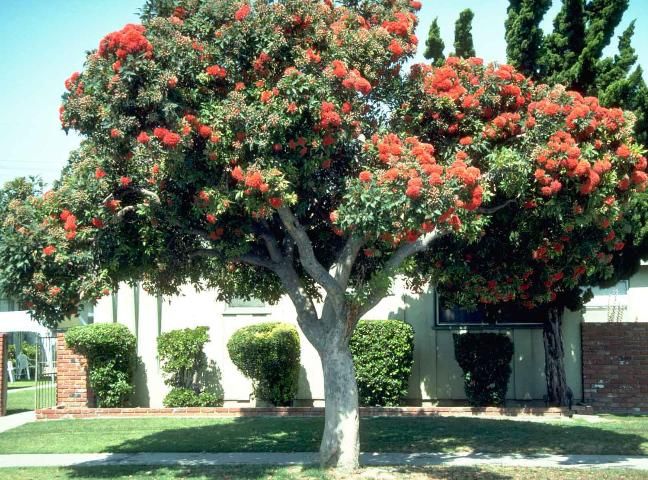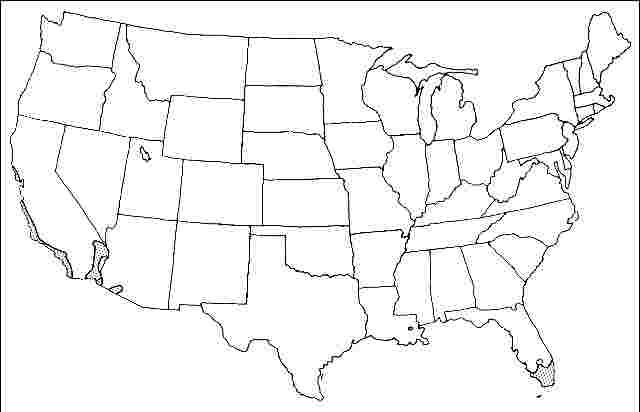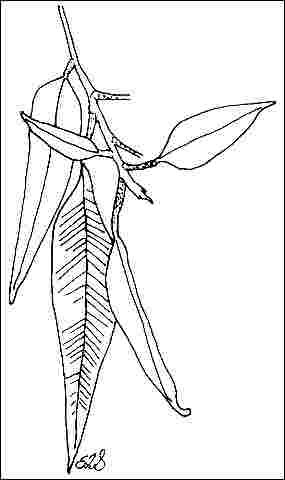Introduction
A native of Australia, Corymbia ficifolia grows best on the western coast of the United States and is seldom successful in the interior. Its flowers are spectacular, and it can be tried as a container plant in the North, wintered indoors. Foliage of eucalyptus is aromatic, with frequent distinguishing differences between juvenile and mature leaves. These plants are used in western landscapes.

Credit: Ed Gilman, UF/IFAS
General Information
Scientific name: Corymbia ficifolia
Pronunciation: core-IM-bee-uh fiss-ih-FOLE-ee-uh
Common name(s): Red flowering gum
Family: Myrtaceae
USDA hardiness zones: 9B through 11 (Figure 2)
Origin: not native to North America
Invasive potential: not assessed/incomplete assessment
Uses: urban tolerant; specimen; highway median; street without sidewalk; tree lawn 3–4 feet wide; tree lawn 4–6 feet wide; tree lawn > 6 ft wide

Description
Height: 30 to 40 feet
Spread: 15 to 25 feet
Crown uniformity: irregular
Crown shape: round
Crown density: moderate
Growth rate: fast
Texture: medium
Foliage
Leaf arrangement: alternate (Figure 3)
Leaf type: simple
Leaf margin: entire
Leaf shape: lanceolate
Leaf venation: pinnate
Leaf type and persistence: fragrant, evergreen, broadleaf evergreen
Leaf blade length: 2 to 4 inches
Leaf color: green
Fall color: no color change
Fall characteristic: not showy

Flower
Flower color: red
Flower characteristics: very showy
Fruit
Fruit shape: round, oval
Fruit length: 1 to 3 inches
Fruit covering: dry or hard
Fruit color: brown, green
Fruit characteristics: does not attract wildlife; showy; fruit/leaves not a litter problem
Trunk and Branches
Trunk/bark/branches: branches don't droop; showy; typically one trunk; thorns
Pruning requirement: needed for strong structure
Breakage: susceptible to breakage
Current year twig color: reddish, brown
Current year twig thickness: thin
Wood specific gravity: unknown
Culture
Light requirement: full sun
Soil tolerances: clay; sand; loam; acidic; slightly alkaline; well-drained
Drought tolerance: high
Aerosol salt tolerance: unknown
Other
Roots: not a problem
Winter interest: no
Outstanding tree: no
Ozone sensitivity: unknown
Verticillium wilt susceptibility: resistant
Pest resistance: sensitive to pests/diseases
Use and Management
Propagation is by seed, using ripe seed capsules taken off trees.
Pests
Pests include psyllids, aphids, mealybugs, scales, mites, caterpillars, and borers. Spraying with soap solution or appropriate chemical sprays will often suffice to control all but the borers. Borer damage may require the cutting out and destroying of infested stems and the removal of dying plants. Psyllids disfigure the tree and can be quite a problem.
Diseases
It is resistant to armillaria root rot and to verticillium wilt. They are susceptible to powdery mildew and to Phytophthora cinnamoni and Phytophthora lateralis.
Leaf spot and crown gall are eucalyptus' major disease problems. Prune infected twigs and branches and be sure to keep dead leaves and fruit cleaned up as plant refuse is usually the source of leaf spot disease.